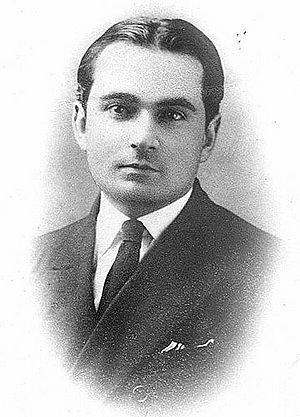Jorge Basadre facts for kids
Quick facts for kids
Jorge Basadre
|
|
|---|---|

Basadre in 1924
|
|
| Born |
Jorge Alfredo Basadre Grohmann
12 February 1903 Tacna, Chile
|
| Died | 29 June 1980 (aged 77) Lima, Peru
|
| Nationality | Peruvian |
| Alma mater | National University of San Marcos |
| Occupation |
|
| Employer |
|
|
Notable work
|
Historia de la República del Perú |
| Spouse(s) | Isabel Ayulo Lacroix |
| Children | 1 |
| Parent(s) |
|
| Awards |
|
| Minister of Education of Peru | |
| In office 28 July 1945 – 6 October 1945 |
|
| President | José Luis Bustamante y Rivero |
| Prime Minister | Rafael Belaúnde Diez Canseco |
| Preceded by | Enrique Laroza |
| Succeeded by | Luis E. Valcárcel |
| In office 28 July 1956 – 1958 |
|
| President | Manuel Prado Ugarteche |
| Prime Minister | Manuel Cisneros Sánchez |
| Preceded by | Juan Mendoza Rodríguez |
| Succeeded by | Ulises Montoya Manfredi |
Jorge Basadre was a famous Peruvian historian. He was born on February 12, 1903, and passed away on June 29, 1980. He wrote many books about Peru's history after it became independent. He also worked as the Minister of Education twice and was in charge of the Peruvian National Library.
Contents
Early Life and Education
Jorge Basadre was born in Tacna. At that time, Tacna was under Chilean control. His parents were Carlos Basadre Forero and Olga Eloísa Grohmann Butler. Jorge's great-grandfather, José Toribio Ara y Cáceres, was a leader who fought in the Peruvian War of Independence.
Jorge first went to Liceo Santa Rosa, a Peruvian school that secretly operated in Tacna. In 1912, his family moved to Lima, and he started attending the German School of Lima. He finished high school in 1918 at Our Lady of Guadalupe National School.
In 1919, Basadre began studying at the National University of San Marcos. He earned his Ph.D. in humanities in 1928 and a law degree in 1935. While studying, he was part of a group of young students called the "Generation of the Reformation." He also worked at the Peruvian National Library from 1919 to 1930.
Basadre became a professor at the National University of San Marcos in 1928. He taught Peruvian History and later the History of the Republic of Peru. He also taught the History of Peruvian Law until 1954. Between 1931 and 1935, he studied in the United States and Germany. He received a scholarship from the Carnegie Institution for Science to study in the U.S. and took courses at the Humboldt University of Berlin. During this time, he also visited Spain to do research in archives at the University of Seville.
Public Service and Contributions
Between 1925 and 1926, Jorge Basadre was part of the Peruvian team sent to southern Peru. Their job was to help organize a vote (called a plebiscite) for the cities of Tacna and Arica. During this work, he was hurt by a stone thrown by a Chilean nationalist. The vote never happened because there were not enough guarantees for a fair process. Two years later, in 1929, Tacna officially became part of Peru again, but Arica remained with Chile.
When he returned to Peru, Basadre became the director of the Central Library at San Marcos University. He reorganized it between 1936 and 1942.
Rebuilding the National Library
On May 9, 1943, a fire badly damaged the Peruvian National Library. Basadre was then chosen to be its director and lead the rebuilding efforts. This was a huge task! He worked tirelessly to replace the lost books and organize the publication of the Library's magazine, Fénix. He also started the Anuario Bibliográfico Peruano, which listed new books published in Peru. After many long hours and challenges, he successfully reopened the renovated National Library in September 1948.
Role as Minister of Education
Jorge Basadre served as the Minister of Education twice.
- The first time was for a short period in 1945, under President José Luis Bustamante y Rivero.
- The second time was from 1956 to 1958, when President Manuel Prado Ugarteche appointed him.
He also taught history at other important institutions, including Colegio Guadalupe and the National Pedagogical Institute. He held a doctoral chair in History of Peru at the Pontifical Catholic University of Peru. He also taught critical history of Peru at the Chorrillos Military School.
Basadre was the secretary general for the XXVII International Congress of Americanists held in Lima in 1939. He was also president of the Historical Institute of Peru (now called the National Academy of History) from 1956 to 1962. He was a member of the Peruvian Academy of Language and the Geographical Society of Lima.
In 1979, he received the highest honor in Peru, the Order of the Sun of Peru, with the degree of Grand Cross.
Personal Life
Jorge Basadre was married to Isabel Ayulo. They had one son, named Jorge Basadre Ayulo.
Legacy and Recognition
Jorge Basadre passed away in Lima on June 29, 1980, at the age of 77.
His contributions to Peruvian history and culture are still remembered today.
- A university in Tacna is named after him: Jorge Basadre Grohmann National University.
- Since 1991, his picture has been on the S/. 100 banknote, which is Peru's official currency.
- In 2008, a province in Tacna was created and named in his honor.
See also


